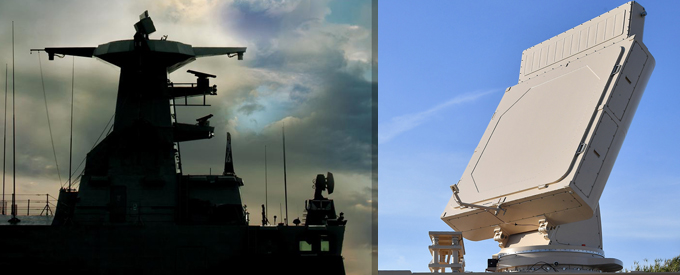2021-05-18
Leonardo’s Focus on AESAs Proves Advantageous
Radars (Radio Detection and Ranging) have been in use for several years, but their evolution has remained closely related to ever-changing threats on the battlefield.
Technological changes have created scope for a high degree of innovation in the design of radar systems.
In particular, an increase in the level of component digitalisation has optimised the use of the power and time – primary resources available in radar – increasing the energy radiated to where it is needed most and reducing the time taken to detect and identify potential threats.
Today’s enemies often do not operate under a single flag, and their threat lies in the existence of systems that vary vastly in conception and technical complexity.
The use of Active Electronically Scanned Arrays (AESAs) in antennas containing large numbers of transmitter-receiver units has substantially altered the name of the game. This offers huge operational advantages.
It is now possible to direct instantaneously the radar beam towards the origins of a possible threat, monitoring several points simultaneously while also varying the observation time.
It is this ability to direct the radars and continuously observe the potential threat that makes them exponentially more effective than their predecessors, which were limited to antennas that perpetually rotated 360° with a constant emission of power in all directions.
AESAs possess the ability to cut power wastage by directing the energy beam onto the target with higher frequency, guaranteeing greater continuity and tracking accuracy on the monitored area.
The modularity of AESAs allows for rapid development of versions based on the same type of system architecture but with different physical configurations suited to the users’ logistical needs.
Examples include mobility, ease of transport and reliability, which help minimise deployment costs and reduce fuel consumption and generator size.
Another characteristic of modern radar system is the ability to operate in a network, and be integrated with other components. This allows the radars to be managed simultaneously by multiple users, providing a different functionality for each user offering greater flexibility and substantial cost reduction.
Within an integrated defence system, AESA sensors such as those of the KRONOS family even -obtain information about the origin of possible threats and can use this to boost detection capacity by increasing the energy radiated in that direction.
KRONOS radar performs surveillance, tracking, threat assessment, missile guidance functions, simultaneously and automatically towards multiple threats. They are highly performing systems, especially in regards to coverage, acquisition speed and tracking continuity, even at low or very low altitudes.
The advantage is that KRONOS radars can be used simultaneously with different surveillance functions and can detect even the smallest air and naval threats, without changing the rotation speed or the operating mode.
An example is the integration of long-range radars (with a range of 400-500 km) such as the Leonardo RAT-31 DL - or its mobile version the RAT-31 DL/M– with an Early Warning function that can considerably increase the nominal range of a KRONOS GRAND.
The RAT 31 DL is an advanced L-band solid state phased array, 3D surveillance radar, effective to a range of over 500 Km. The RAT 31 DL is a state-of-the-art radar system designed to operate within modern military Air Defence systems. It is a direct derivative of the successful RAT 31 SL.
In-house Technology
Leonardo, one of the world’s major players in Aerospace, Defence and Security, has invested significant resources in AESAs from the very beginning.
One of the key steps the company took was its investment in its own foundry for the development of gallium nitride MMICs (Monolithic Microwave Integrated Circuits) used to produce radiant modules for AESA systems. Having this technology in-house helps Leonardo to be independent of third-party suppliers and also constantly innovate.
The KRONOS family of multifunctional AESA radars was born from this technology, simultaneously and automatically performing surveillance, tracking and missile guidance functions against manifold threats.
The KRONOS family (available in the different frequency bands, L, C, and X) is available for both naval and land-based operations. The first one includes the KRONOS NAVAL for short-medium-range applications, the medium/long-range GRAND NAVAL and the long-range/ATBM POWER SHIELD, in rotating configuration; the DUAL BAND, in QUAD or STARFIRE fixed configurations.
The equivalent ground-based radars are the LAND, the GRAND MOBILE, the GRAND Mobile HP and the GROUND SHIELD available in mobile/transportable/fixed configuration; almost 50 KRONOS radars have been delivered to the Italian armed forces, as well as worldwide.
KRONOS radars can detect even small air and naval targets in the same scan, maintaining a single operating mode.
That very well sums up their strength.


No Comments